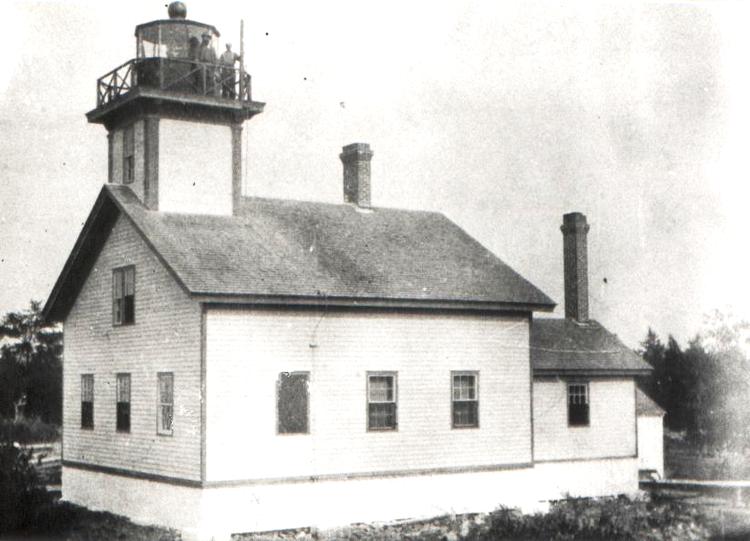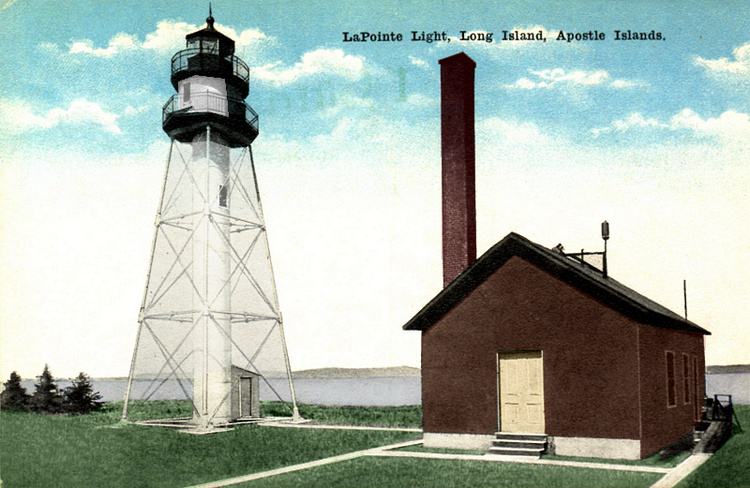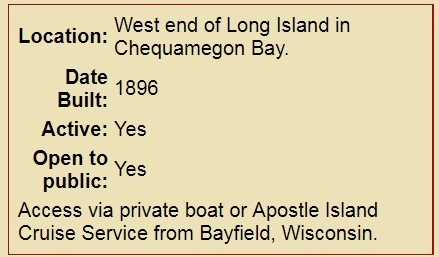The Nation’s Largest Collection Of Lighthouse Bloopers, Part 3
Continuing an examination of the series of articles on the lighthouses of the Apostle Islands appearing on the maritime web site, boatnerd.com.
Back to Part 2
Part Three: The La Pointe Light Station
Under discussion:
The La Pointe Light, by Dave Wobser
Chequamegon Point Light, by Dave Wobser
Now to examine the articles on the three towers built over the years on Long Island, the slim sandbar that separates Chequamegon Bay from the rest of Lake Superior.

The First La Pointe Lighthouse (1858)
One year after the ill-advised construction of the Apostle Island’s first lighthouse on Michigan Island, a small wooden lighthouse was built at the site on Long Island where the light was originally supposed to be. It is presumed, though not yet conclusively documented, that officials in Washington were unhappy with their field representative Abraham Smolk’s unilateral revisions to the plans, and insisted on placement of a light at the proper site. Somewhat confusingly, it was referred to as the La Pointe light, in reference to the harbor it was built to mark, on neighboring Madeline Island.
Mr. Wobser gets quite a bit wrong in his article on this lighthouse and the two later built to replace it.
Long Island is in reality a disconnected piece of land at the end of Chequamegon Point..
A look at an up-to-date map would have prevented a painful boner here. While a shallow, “now-you-see-it, now-you-don’t” channel has separated Long Island from the rest of Wisconsin on and off over the years, the so-called island has been connected to the mainland since 1975, when the “Edmund Fitzgerald” storm filled in the cut thoroughly enough to hold since then.
The first light, built in 1858, was a wooden platform that displayed the light through a Fourth Order lens. An attached clapboard dwelling was later constructed but only the foundation remains.
I can’t imagine where Mr. Wobser got this idea of a beacon sitting by itself on a bare wooden platform. Where, pray tell, was the keeper supposed to stay on the barren sandbar before someone got around to building him a house? In fact, it’s quite clear that the original, schoolhouse-style lighthouse was built in one piece. Among other references, a letter written in 1863 by keeper D.J. Cooper complains, “The house also needs painting, it has not been painted since the season it was built (1858).”
In 1897, the original La Pointe lighthouse was replaced by two new towers, roughly three-quarters of a mile apart: the “New La Pointe” tower, east of the original lighthouse, and the Chequamegon Point tower at the island’s tip. One keeper, with two assistants, was responsible for both lights.

The "New La Pointe" tower and the long-gone fog signal.
Turning to the New La Pointe tower:
The present white steel tubular structure, supported by four skeletal legs, was erected in 1896… adjacent to the 1890 fog signal building.
Off by a year on both buildings. Construction of the light tower was begun in the fall of 1896, but the crew was called away to work elsewhere at the end of October. Work was not resumed until the following August, and the new tower finally placed in service on October 11, 1897. Work on the fog signal began in October 1890, but was not complete until early the following year.
Two structures are adjacent to the tower. One is a rectangular frame building, sided with corrugated iron, that was erected… to house a fog signal.
Sorry to break the news, but the Coast Guard demolished that building in 1986. Please try to keep up.
| The New La Pointe Lighthouse, according to Boatnerd. |
Chequamegon Point Light, according to Boatnerd. |
 |
 |
The reality:
Actually built 1897.
Open to the public? Nuh-uh. |
The reality:
Built 1897.
Open to the public? Hell, no!
|
Now, we’ll trudge through the sand to the tip of Long Island, where we come to the Chequamegon Point Light. Right off the bat there's a problem, because the little table at the top of the page says the light is open to the public. Um, no.
But then it gets worse.  According to Mr. Wobser, According to Mr. Wobser,
The original Chequamegon Light was established on the western end of Long Island in 1868 to mark the entrance to Chequamegon Bay... It was replaced in 1896 by a square, white steel room on steel legs.
Oh. My. God.
SAY WHAT?
Where in the world did this 1868 lighthouse come from?
If I had to pick a low point in this swamp of misinformation, it would probably be here, where Mr. Wobser makes up a lighthouse that never existed.
There is absolutely no record of a lighthouse built here in 1868.
Zero, zip, zilch.
Not in the reports and correspondence of the Lighthouse Board, not in any keepers’ log books, not in letters or diaries or news reports of the day. In fact, what we do have are land records showing that the government only bought the site from a private owner in 1895, in order to build a lighthouse on it.
The one that was completed in 1897, not 1896, and whose upper portion is made out of cast iron, not steel.
Please go on, sir.
These two lights are located about one mile from the La Pointe Light.
“Two lights?” Huh? Now I’m really confused. Is he talking about the one that never existed and the one that was built a year later than when he thought it was, or is he… never mind, screw it. Let’s just go on.
Access is by walking from the dock at the La Pointe station along the beach. At one time, a boardwalk connected the two lights, and early light keepers rode bicycles from the La Pointe station to tend the Chequamegon Point light.
The image of keepers riding bicycles back and forth on the concrete sidewalk (not boardwalk) between the two towers may be charming, but I am unaware of any evidence that it actually happened. The surviving volumes of the keeper’s log, which cover the years 1872 to 1943 and include considerable detail about daily life at the station, make no reference to a bicycle, nor is there mention of bicycles in any of several interviews with keepers’ children conducted in the 1980s. Perhaps Mr. Wobser has access to other sources of information than these; if so I hope he will share them with the rest of us.
Next: The Raspberry and Outer Island Lights
|